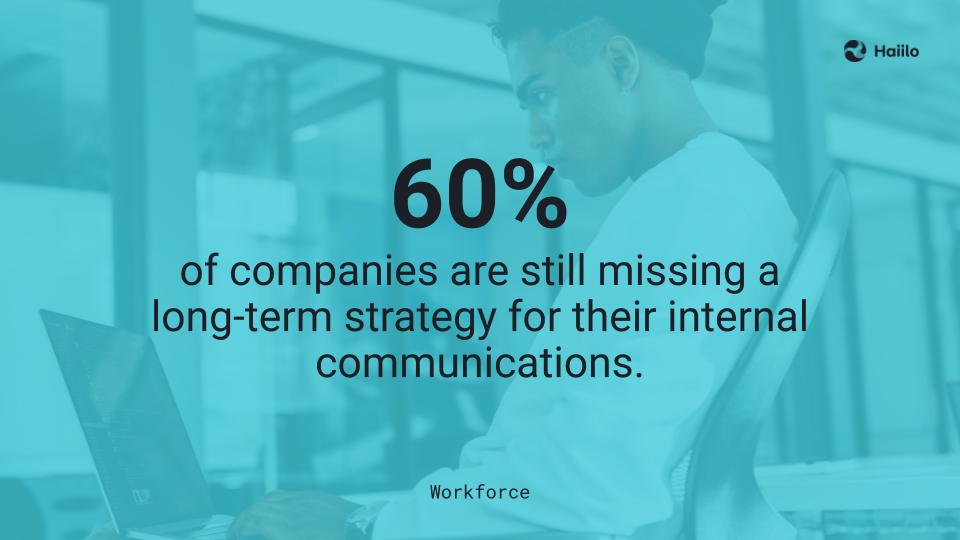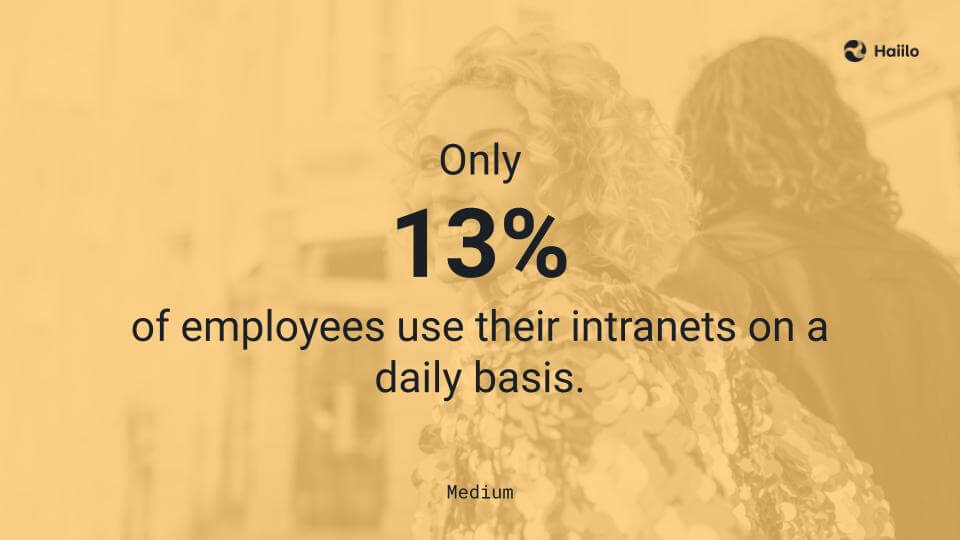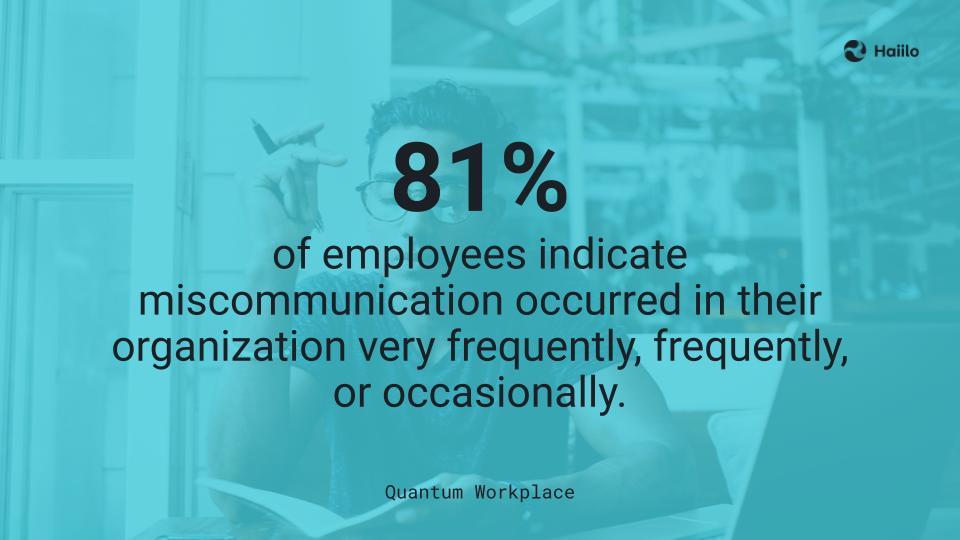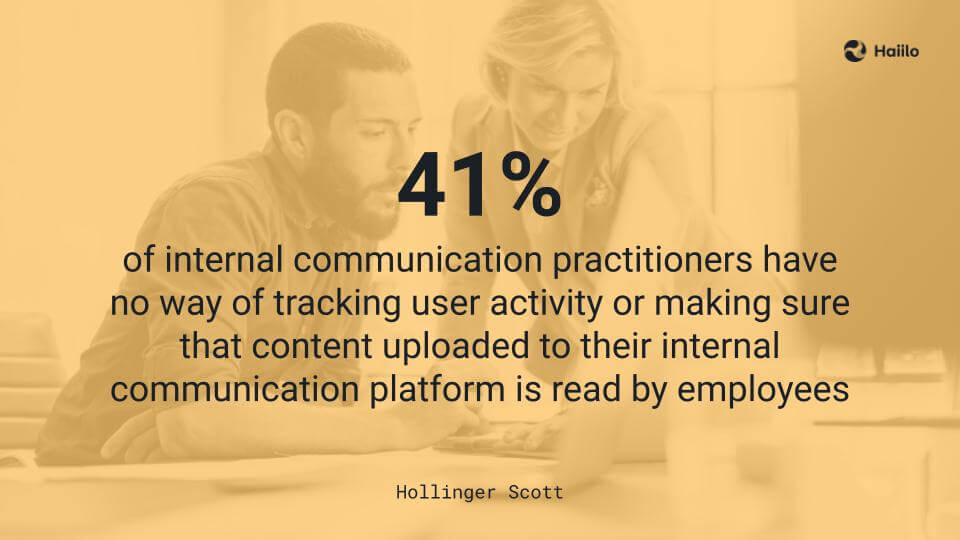Effective employee communication can transform your organization in so many different ways! And yet, many employees are not so happy with the way their employers communicate with them.
This is why we have put together the main mistakes employers make when communicating with their employees as well as best practices for avoiding these mistakes.
💡Download our eBook “Building a Better Company with Internal Communications” and learn how to improve team communication in the workplace!
4 Main Reasons Why Employee Communication Matters
Let’s first take a look into the 4 main reasons why employee communication is important:
1. Employee communication improves employee engagement
Ragan’s research on employee engagement shows that employee communication statistically correlates with how engaged employees are.
But why should we care about employee engagement after all?
A Gallup research showed that the organizations in the 1st quartile (top 25%) of employee engagement scores achieved dramatically better operational performance than organizations in the 4th quartile (bottom 25%) as follows:
- 10% higher in customer loyalty/engagement
- 21% higher in profitability
- 20% higher in productivity — sales
- 17% higher in productivity — production records and evaluations
- 24% higher in turnover for high-turnover companies (those with more than 40% annualized turnover)
- 59% higher in turnover for low-turnover companies (those with 40% or lower annualized turnover)
- 70% higher in fewer safety incidents
- 28% higher in reduced shrinkage (shop stealing and similar)
- 41% higher in less absenteeism
- 58% higher in patient lower safety incidents
- 40% higher in quality (fewer defects)
2. Employee communication increases employee productivity
Because of the information overload that most businesses are facing, employees often spend too much time searching for important content.
Think about it: an average employee spends 2.5 hours every day searching for the information they need. Monthly, this roughly results in an entire week of time searching for information!
Below are a few ways how great internal communications improve employee productivity:

Employee communication reduces employee turnover
Companies with more engaged and satisfied employees enjoy much lower turnover rates. To attract and retain younger generations, employers have to make sure that their employees get all the information they need at any time.

But that doesn’t mean that you need to share the same information with your entire workforce. Indeed, information overload often leads to stress, disengagement, frustration and, with that, lower employee retention.
If you want your employees to engage with your content, you’ll need to personalize your messages and make sure that your employees receive the information they need.
4. Employee communication influences company’s financial stability
According to the research done by the Society for Human Resource Management (SHRM), many companies are losing money due to poor communication.
One survey of 400 companies with 100,000 employees cited an average loss per company of $62.4 million per year due to the poor communication among employees. In addition, miscommunication cost smaller companies of 100 employees an average of $420,000 per year!
More Benefits of Effective Employee Communication
The benefits of effective employee communication mentioned above are not the only ones. Check out our infographic with some other benefits of great employee communication in the workplace 👇

12 Employee Communication Mistakes to Avoid
Let’s now take a deep dive into some of the most common employee communication mistakes and how to avoid them.
1. Infrequent and inconsistent communication
Most employees believe that their employers are not good communicators. Infrequent and inconsistent communication is the main reason for such dissatisfaction among employees. When employees are missing out on important company updates, they start feeling isolated or insecure.

💡 How to avoid this mistake
In order to have all your employees on the same page and up-to-date with important information, internal communicators have to make sure they reach the right employees at the right time with the right messages.
Communication also needs to be consistent throughout the whole workplace and on all various communication channels your organization uses.
2. Not having a clear internal comms strategy
Today, IC practitioners are considered as key business partners. Accordingly, they should also have clear strategies around how to communicate with and influence people.
However, many internal comms departments still don’t have a clear employee communication strategy in place.

💡 How to avoid this mistake
As employee comms has a strong impact on employee engagement and performance, your IC team needs to to find ways to encourage your employees to go the extra mile.
Organizations need to be more aware of the impact of workplace communication on business success. This is why, when building and launching a communication strategy, it is crucial to have the executives on board and get their support.
3. Not understanding your audience
When it comes to employee communication, the key is to have a clear understanding of your internal audiences.
The same way marketing and sales professionals need to understand their audiences to catch potential customers’ attention, internal communicators need to understand their employee personas.
Internal communicators that don’t have this understanding of their internal audiences can’t successfully connect with their employees and gain their attention.
💡 How to avoid this mistake
Before launching your internal communication strategy, try to get a better understanding of your employees, their needs and the comms channels they prefer to use.
If you manage to better understand your audience and adjust your IC strategy accordingly, your employees will read and engage with your content.
4. Irrelevant information and lack of content personalization
This mistake comes hand-in-hand with the previously covered challenge. Understanding your audience is just the first step in creating exceptional employee experience.
Remember, not every employee should receive every piece of information. Not only does this situation create information overload which hurts employee productivity, but it also results in lower engagement levels with content that is actually relevant to them.
Luckily, employee communication solutions like Haiilo enable employers and employees to create personalized news feeds based on various criteria to make the content more relevant to employees’ positions, locations, preferences and interests.
That way, content creators can push out specific messages to each relevant audience, with relevant articles and content populated on the users’ news feeds.
💡 How to avoid this mistake
Everyone is talking about the importance of treating employees the same way customers are treated. Personalized internal communication plays an important role in creating such an employee experience.
Again, we need to follow best practices from sales and marketing departments for whom content and communication personalization are must-haves!
5. One-way communication and neglecting employee voice
Employers need to do a better job at supporting two-way conversations and making employees feel they can speak up and engage in daily conversations.
Sending out a newsletter with a company update does no good if your employees can’t join the conversation. And this is often one of the main reasons why internal messages get ignored.
Do you find the fact that roughly half of employees don’t speak up their mind at work as shocking as I do?
💡 How to avoid this mistake
Open. Transparent. Two way. This is the golden rule for efficient employee communication strategy. However, in order to engage employees in two-way conversations, employers need to put extra effort into ensuring that employees feel that their voice matters.
However, if you encourage your employees to speak up, you have to be ready to act upon their feedback.
Stop neglecting your employees’ voices!
We give you the tools to create great two-way conversations
6. Lack of fun and engaging content
If you don’t consider your internal content fun and engaging, your employees won’t either! Yet, a lot of internal content that employers create is just about informing employees on certain updates. Internal content should be much more than that, and your employees should be able to find inspiration in it.
Internal communicators today should have creative and other marketing-like skills. They need to be able to create content that will catch employees’ attention and interest.
💡 How to avoid this mistake
Back to sales and marketing… Why do you think marketers create so many videos, podcasts and webinars? Well, because this type of content is much more engaging, and it is easier and more fun to consume!
7. Wrong communication channels
This is one of the top employee communication challenges and for that reason it needs a special attention.
Many employers are not even aware of how many different communication channels their employees are using. Why do we then get surprised when important information gets lost and buried?

Slack, Microsoft Teams, SharePoint, Google Drive, Intranets, emails, project collaboration tools… these are all various means of internal employee communication. No wonder why it is so hard to reach every employee with important information!
💡 How to avoid this mistake
This internal communication ecosystem will continue to grow, but it is on the employers to consider new solutions that connect all those channels.
Your employee communication solution should be the central hub for corporate communication, aggregating tools and channels into a single communication place.
Your content from newsletters, podcasts, Intranets, social networks or other employee communication channels could all be connected with a solution like Haiilo.
By doing this, you’re providing a single point of entry for employees to stay connected, all while helping them to find the information they need in no time.
8. Desktop-only communication
Organizations that limit their internal comms to desktop-only communication risk lower engagement with the internal content.
Modern employee communication platforms should, therefore, mimic the look, feel and experience of social media platforms that employees use in their private lives.
💡 How to avoid this mistake
Employers need to be able to walk in their employees’ shoes and better understand employees’ communication preferences. Millennials and Gen Z employees are used to accessing everything on their phones, and they expect the same from communication at work.
It is time for employers to become aware of the benefits of implementing mobile-first employee communication solutions and have a better understanding of how these tools are transforming organizational culture and employees’ behaviors.
9. Too much noise and miscommunication
Employees know that miscommunication happens across their workplace, but they don’t think they are a part of the problem.
A lot of employees believe that miscommunication occurs in their organizations frequently.

💡 How to avoid this mistake
Miscommunication mostly occurs in organizations where open and honest conversations are an exception, not the rule.
Here, leadership communication plays a very important role. When miscommunication happens, leaders should be able to resolve miscommunication that happen within their own teams and company-wide.
10. Not measuring internal comms
A lot of companies are still not measuring the effectiveness of their internal comms. Without measurement, there is no improvement. In other words, employers need to switch to a data-driven mindset when implementing and optimizing their IC strategy. There should be no guessing but making better decisions based on real data.

💡 How to avoid this mistake
Your employee communication software solution should have up-to-date usage analytics to help you understand all the various aspects of your internal comms.
The reports should give you insights into how engaged your employees are and whether or not those insights tie to your ultimate business goals.
11. Neglecting the needs of non-wired and remote employees
When it comes to internal comms, non-wired and remote employees need special efforts from their employers.
Often times, poor communication is the major reason for poor experience and low job satisfaction among these employees.
💡 How to avoid this mistake
Non-wired front-line employees should, before everything, have an easy way to access all the important information the same way office employees have.
One of the main reasons why these employees are unsatisfied with internal comms is because they are not in the loop with important happenings and don’t have a way to join daily company conversations.
Again, mobile employee communication is the best solution to overcome this challenge.
12. Wrong communication technology
All the above mentioned mistakes are impossible to solve if you don’t have the right employee communication technology in place.
Even though there are many available solutions out there, only a few can really eliminate the biggest employee communication challenges.
As seen earlier, emails and Intranets don’t bring enough value to your workplace communication strategy.
💡 How to avoid this mistake
Consider using a modern employee communication solution such as Haiilo. These new solutions are built and designed having all the challenges mentioned above in mind. They are built for modern workplaces that strive towards providing an exceptional employee experience.
Choosing the Right Employee Communication Technology
So, how to make sure that you choose the right employee communication solution for your organization?
When evaluating solutions, ask yourself these questions:
- Can I easily reach all employees with relevant information and updates?
- Am I able to reach all employees regardless of their location?
- Can I create and share personalized content that drives employee engagement?
- Is there a way to make all the content easily shareable within and outside the organization?
- How can the solution help me achieve a complete organizational and strategic alignment?
- Will the solution help employees keep important documents, messages and conversations in one place?
- Will it enable employees to have instant access to information on their mobile phones?
- Can I filter and prioritize content delivery to prevent information overload in the workplace?
When you can positively answer these questions, that means that you have found the right communication solution for your employees!









